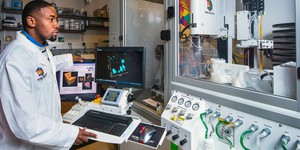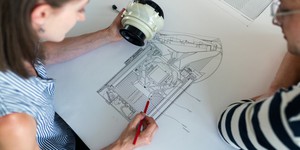Log In
Summary
*Note:
For this science project you will need to develop your own experimental procedure. Use the information in the summary tab as a starting place. If you would like to discuss your ideas or need help troubleshooting, use the Ask An Expert forum. Our Experts won't do the work for you, but they will make suggestions and offer guidance if you come to them with specific questions.
If you want a Project Idea with full instructions, please pick one without an asterisk (*) at the end of the title.
If you want a Project Idea with full instructions, please pick one without an asterisk (*) at the end of the title.
Abstract
If you're interested in analyzing how things break, check out the Science Buddies project Fractography: The Way Things Break.Ask an Expert
Do you have specific questions about your science project? Our team of volunteer scientists can help. Our Experts won't do the work for you, but they will make suggestions, offer guidance, and help you troubleshoot.
Careers
If you like this project, you might enjoy exploring these related careers:
Career Profile
Mechanical engineers are part of your everyday life, designing the spoon you used to eat your breakfast, your breakfast's packaging, the flip-top cap on your toothpaste tube, the zipper on your jacket, the car, bike, or bus you took to school, the chair you sat in, the door handle you grasped and the hinges it opened on, and the ballpoint pen you used to take your test. Virtually every object that you see around you has passed through the hands of a mechanical engineer. Consequently, their…
Read more
Career Profile
What makes it possible to create high-technology objects like computers and sports gear? It's the materials inside those products. Materials scientists and engineers develop materials, like metals, ceramics, polymers, and composites, that other engineers need for their designs. Materials scientists and engineers think atomically (meaning they understand things at the nanoscale level), but they design microscopically (at the level of a microscope), and their materials are used macroscopically…
Read more
Career Profile
You use mechanical devices every day—to zip and snap your clothing, open doors, refrigerate and cook your food, get clean water, heat your home, play music, surf the Internet, travel around, and even to brush your teeth. Virtually every object that you see around has been mechanically engineered or designed at some point, requiring the skills of mechanical engineering technicians to create drawings of the product, or to build and test models of the product to find the best design.
Read more
Related Links
Cite This Page
General citation information is provided here. Be sure to check the formatting, including capitalization, for the method you are using and update your citation, as needed.MLA Style
Science Buddies Staff.
"How Things Break." Science Buddies,
20 Nov. 2020,
https://www.sciencebuddies.org/science-fair-projects/project-ideas/MatlSci_p032/materials-science/how-things-break?class=AQUygiAGcY1u1YCXoX77lWEPZ8tGvz3SfUVi5MAJzbFKSTrA-NkQwUG_zMAaPVfkZviG5y841bfk4U1vmdRW50_v.
Accessed 24 Apr. 2024.
APA Style
Science Buddies Staff.
(2020, November 20).
How Things Break.
Retrieved from
https://www.sciencebuddies.org/science-fair-projects/project-ideas/MatlSci_p032/materials-science/how-things-break?class=AQUygiAGcY1u1YCXoX77lWEPZ8tGvz3SfUVi5MAJzbFKSTrA-NkQwUG_zMAaPVfkZviG5y841bfk4U1vmdRW50_v
Last edit date: 2020-11-20
Explore Our Science Videos
Design a Seeding Machine
How to Make Magnetic Slime
Make a Thermometer - STEM Activity









